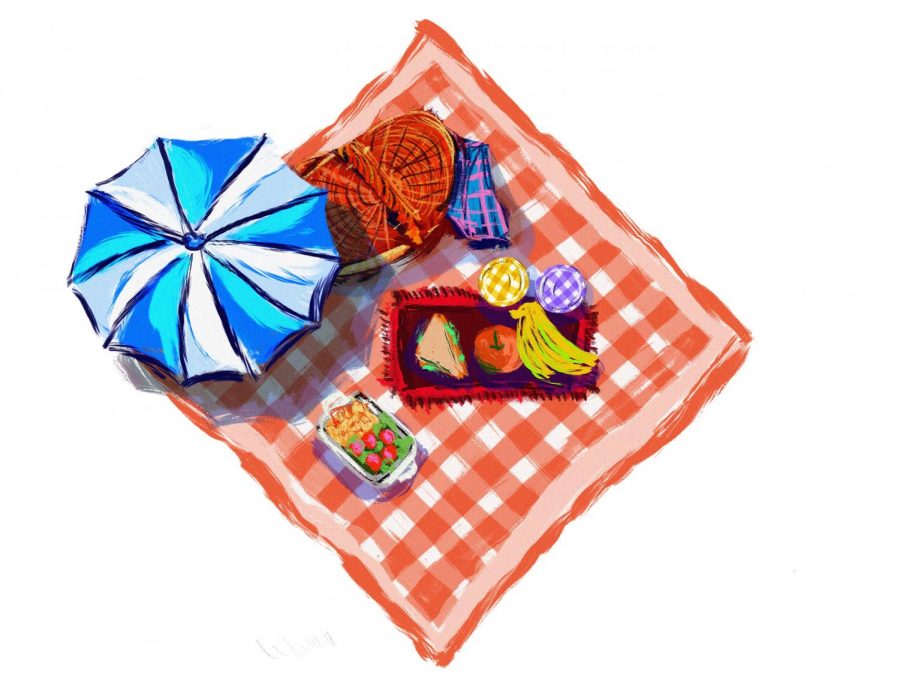Students, staff share experiences with vegan diets
Graphic by Jamie Wang
“How do you do it?” “I can’t believe you can live without bacon!” These are questions that sophomore Pablo Brunet is used to hearing from new acquaintances. Reportedly, he only misses fish sticks.
It’s been seven years since Brunet’s parents decided to switch from vegetarianism to veganism. So long as he shares a fridge with them, it’s likely that he’ll share the same diet. “They buy the food in my house,” he said. “I just eat what they eat.”
For Brunet, being vegan means avoiding all foods that include animal products, including meat, dairy and eggs. To compensate for nutritional deficiencies, he finds alternative sources, such as tofu.
While vegan dietary restrictions may be difficult to adjust to, some vegans, like Brunet’s parents, make the change from being vegetarian. English teacher Paulette Sato was a vegetarian for 15 years before finally deciding to go vegan. “Being a vegetarian first really helped, because that’s the biggest distinction: going from meat to non-meat,” she said. “Becoming a vegan is just fine tuning.”
Sato chose to adopt veganism for humane reasons. After learning how companies obtain animal products, she decided not to support animal abuse or mistreatment in any way. “I started to realize that factory farming—how they got eggs and the way they treated the cows to get milk—was just not humane,” Sato said. “It wasn’t something that I wanted to engage in.”
Not only does Sato steer clear of animal-related food products, she also makes an effort not to buy any products with connections to animal mistreatment or testing. For example, she is careful to buy from makeup companies that do not participate in animal testing.
Despite maintaining strong personal values, Sato refrains from imposing her lifestyle upon others. “Sometimes, people perceive you as being someone who’s trying to school everyone else,” she said. “I gave that up a long time ago. I think that everybody has to make his or her own choice in life.”
That said, being vegan is not always easy. Brunet sometimes finds it difficult to find food options, especially when eating out. “If you’re with your friends and you have to order a salad, it’s pretty depressing,” he said.
Still, in the modern world, there are many new vegan alternatives, from the meatless “Beyond Burger” by the company Beyond Meatto plant-based dairy products of Miyoko’s Creamery. Sophomore Reva Shah, who became vegan as a lactose intolerant vegetarian, has explored many of the available vegan products. “They haven’t really found a good way to make vegan cheese,” she said. “But they’ve come along way with vegan ice cream. It tastes like actual ice cream, which is really good. And Oreos are vegan, and I love Oreos now.”
Of course, it’s always possible to experiment and come up with new vegan recipes. Junior Lila Sanchez brought her creativity with baking into her vegan lifestyle. “Whenever I make baked goods, I always find some way to make them vegan, and for the most part, people enjoy them,” she said.
Sanchez, who has not eaten meat in five years, is satisfied by the health and environmental benefits of being vegan. While she’s never liked eating meat, she’s glad to avoid the potential carcinogens while feeling healthier and more energetic.
For those contemplating veganism, she suggests taking an optimistic, step-by-step approach. “Some people can get discouraged if they’re like, ‘Oh my god, I can’t eat this. I can’t eat that. What can I eat?’” she said. “Getting to know all of the foods that you can eat can be a lot more encouraging than just focusing on what you can’t.”
Thus, while a lifetime without bacon, fish sticks or cheese might seem daunting, the hope is to make a positive impact. “I think it’s my way of giving back, trying to minimize bad treatment towards animals,” Sato said. “There are a few things in life that I couldn’t live without. Animals would be one.”
— Written by Jessica Wang
Your donation will support the student journalists of Henry M. Gunn High School. Your contribution will allow us to purchase equipment and cover our annual website hosting costs.


